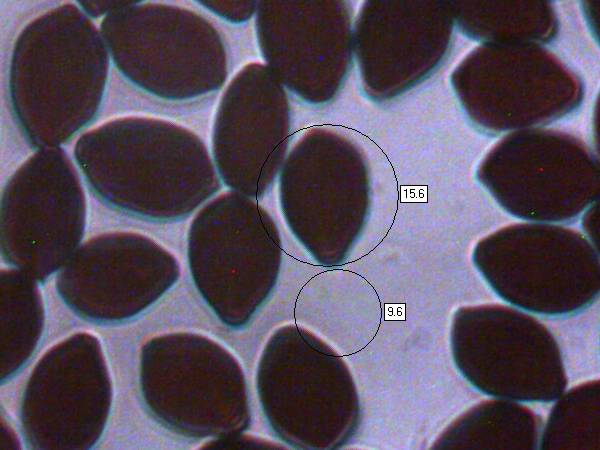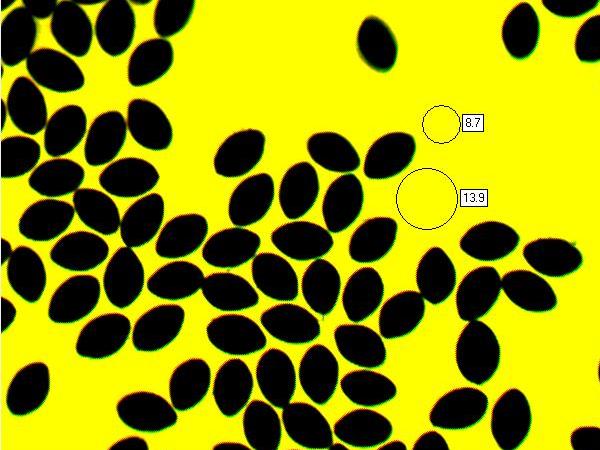Panaeolus papilionaceus (Bull.) Quél. - Petticoat Mottlegill
Phylum: Basidiomycota - Class: Agaricomycetes - Order: Agaricales - Family: Insertae sedis (Not yet assigned)
Distribution - Taxonomic History - Etymology - Identification - Culinary Notes - Reference Sources
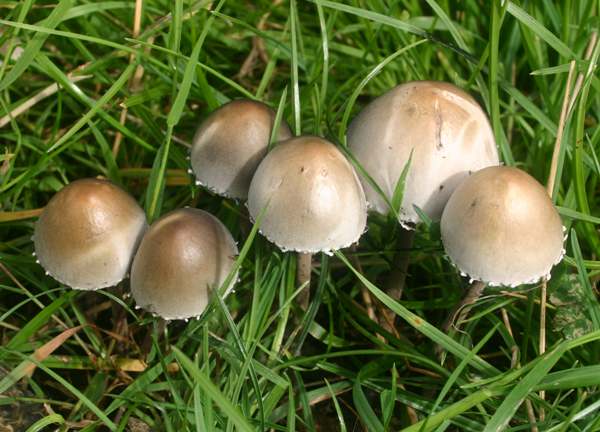
A neatly serrated edge to the cap margin, consisting of remnants of the partial veil, makes this a rather attractive dung fungus and is the source of its common name. Among its many synonyms this species is recorded in many field guides as Panaeolus sphinctrinus.
A late coloniser of dung in farm fields, this mushroom often appears in groups and is most commonly seen where dung has rotted down and become overgrown with grass.
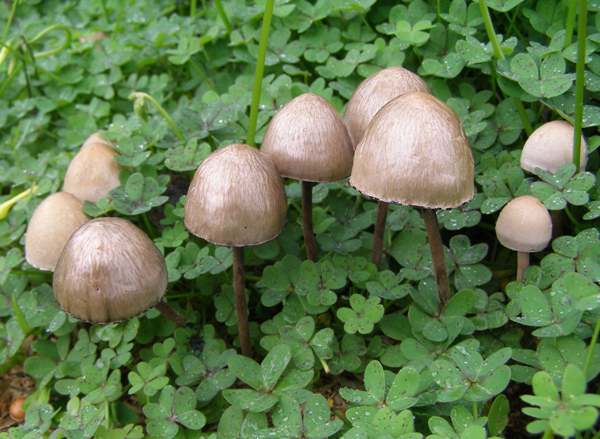
Distribution
This dung-loving (coprophilous) mushroom is widespread and abundant throughout Britain and Ireland as well as in other European countries. Panaeolus papillionaceus is also native to North America, where it is equally common.
Taxonomic history
This mushroom was originally described in 1781 by French mycologist Jean Baptiste Francois Pierre Bulliard, who gave it the scientific binomial name Agaricus papilionaceus. (Most gilled fungi were initially placed in a giant Agaricus genus, but the majority have since been redistributed to other genera leaving the 'true mushrooms' in Agaricus.)
It was another Frenchman, Lucien Quélet, who in 1872 transferred this species to its current genus, whereupon its name became Panaeolus papillionaceus.
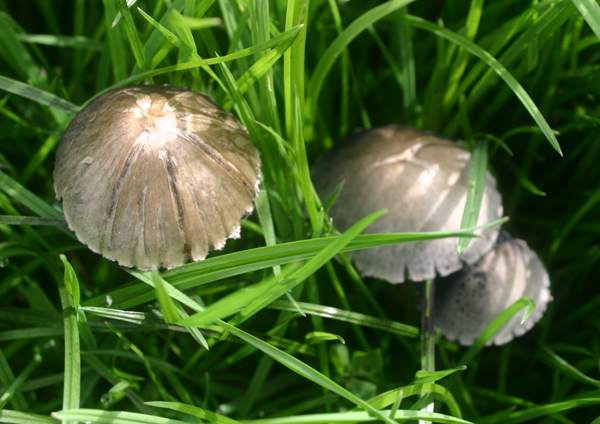
In 1996 a small-spored variety lacking veil fragments around the cap margin was defined and named Panaeolus papilionaceus var. parvisporus Ew. Gerhardt; the full name of the nominate form has therefore become Panaeolus papilionaceus var. papilionaceus (Bull.) Quél.
Synonyms of Panaeolus papillionaceus include Agaricus campanulatus Bull., Agaricus papilionaceus Bull., Coprinus papilionaceus (Bull.) Gray, Agaricus retirugis Fr., Agaricus sphinctrinus Fr., Panaeolus campanulatus (Bull.) Quél., Panaeolus papilionaceus (Bull.) Quél., Panaeolus sphinctrinus (Fr.) Quél., Panaeolus retirugis (Fr.) Gillet, and Panaeolus campanulatus var. sphinctrinus (Fr.) Quél.
Panaeolus papilionaceus is the type species of its relatively small genus, which does not yet have an agreed family position.
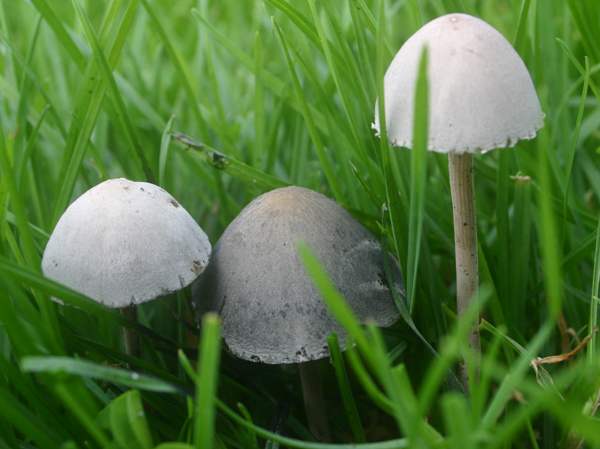
There is no concensus about the correct taxonomic position of fungi in the genera Panaeolus and Panaeolina, which some authorities include in the family Strophariaceae and others in the Bolbitiaceae. (I have placed our pictures of this species in with those of other members of the family Bolbitiaceae.)
Etymology
The generic name Panaeolus means variegated - a reference to the mottling on the gills of fungi in this genus - while the specific epithet papilionaceus means 'resembling a butterfly'... okay, but these mushrooms don't resemble any butterfly that I have ever seen, so until I have seen a very different kind of butterfly this will probably have to remain something of a puzzle. The old specific epithet sphinctrinus means 'tightly bound' and may refer to the fact that the cap does not expand as widely as most agaric mushrooms do.
What is a little easier to understand is the choice of common name: the partial-veil fragments that adhere to the cap rim resemble the frilly hem of a petticoat.
Identification guide
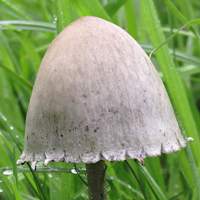 |
Cap2 to 4cm across; initially conical, expanding to become bell shaped but never flattening; hygrophanous, pale brown or grey-brown with a darker centre, drying pallid grey; smooth and silky, sometimes cracking radially in dry weather (see picture above); with tooth-like velar remains hanging from the rim. |
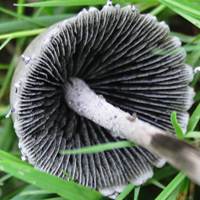 |
GillsPanaeolus papilionaceus gills are adnate; they are pale grey-brown with white edges, becoming mottled dark brown and then black at maturity. Stem6 to 12cm long and 4 to 8mm diameter; colour as cap but covered in a fine white powder; cylindrical; no stem ring. |
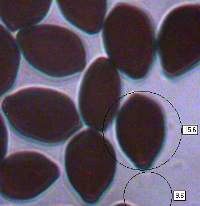 |
Spores - Panaeolus papilionaceus var. papilionaceusEllipsoidal to lemon shape, smooth, 12-16 x 7-9μm; with a germ pore. The spores shown on the left are from Panaeolus papilionaceus var. papilionaceus. Spore printBlack. |
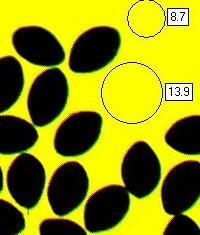 |
Spores - Panaeolus papilionaceus var. parvisporusSpores of this variety are smaller, a flattened lemon shape, smooth, 11.5-14 x 7.5-10.5 x 6.7-8.6μm; with a small germ pore. The spores shown on the left are from Panaeolus papilionaceus var. parvisporus. Spore printBlack. |
Odour/taste |
Not distinctive. |
Habitat & Ecological role |
Saprobic, on dung or well-manured soil, particularly in permanent pastures and grazed common land. |
Season |
June to November in Britain and Ireland. |
Similar species |
Stropharia semiglobata, the Dung Roundhead, has a transient ring and leaves a brown spore print. Panaeolus fimicola, the Turf Mottlegill, has a dark-brown cap when wet and dries out to become mid brown. |
Culinary Notes
Some authorities say that the Petticoat Mottlegill is an edible mushroom, but others categorise it as inedible. In view of the fact that it is such an insubstantial mushroom (and it grows on dung!) and that there is a risk of confusing it with other members of the same genus that contain the hallucinogen psilocybin in significant quantities, I must recommend that this mediocre mushroom be treated as 'for viewing, not chewing'.
Reference Sources
Pat O'Reilly; Fascinated by Fungi, 2016.
Dictionary of the Fungi; Paul M. Kirk, Paul F. Cannon, David W. Minter and J. A. Stalpers; CABI, 2008
British Mycological Society (2010). English Names for Fungi
Taxonomic history and synonym information on these pages is drawn from many sources but in particular from the British Mycological Society's GB Checklist of Fungi.
Fascinated by Fungi. Back by popular demand, Pat O'Reilly's best-selling 450-page hardback book is available now. The latest second edition was republished with a sparkling new cover design in September 2022 by Coch-y-Bonddu Books. Full details and copies are available from the publisher's online bookshop...
